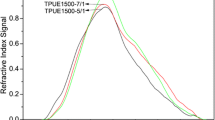Abstract
A series of polyamide-6 elastomers (PAEs) employing polytetramethylene glycol (PTMG) as soft segments, diphenylmethane diisocyanate (MDI) as chain extender and polyamide-6 as hard segments is prepared through reactive processing. The MDI is also employed to suppress the crystallization capacity of soft segments and to regulate the soft segment length in the obtained PAEs. The chemical structures, crystallization properties, morphology, mechanical properties and thermal stability are extensively studied by Fourier transform infrared spectroscopy (FTIR), Hydrogen nuclear magnetic resonance (HNMR), X-ray diffraction (XRD), Differential scanning calorimetry (DSC), Transmission electron microscope (TEM), Dynamic mechanical analyzer (DMA), Tensile test and Thermal gravity analysis (TGA), respectively. TEM images demonstrate that PAE samples exhibit a microphase separated morphology with polyamide-6 domains disperse in the PTMG phase in nano-scale. DMA curves indicate that the prepared PAEs possess a typical elastomer thermodynamic behavior and a broad temperature-independent rubbery plateau. Meanwhile, PAEs exhibit superior mechanical properties with 55 MPa for tensile strength and 1100% for elongation at break. The TGA prove that the thermal stability of PAE can satisfy the requirement of multiple-processing without decomposition.








Similar content being viewed by others
References
Li S, Sang Z, Zhao J, Zhang Z, Cheng J, Zhang J (2016) Synthesis and properties of non-isocyanate aliphatic crystallizable thermoplastic poly(ether urethane) elastomers. Eur Polym J 84:784–798
Jung HS, Choi MC, Chang Y, Kang P, Hong SC (2015) Facile preparation of thermoplastic elastomer with high service temperature from dry selective curing of compatibilized EPDM/polyamide-12 blends. Eur Polym J 66:367–375
Castagna AM, Pangon A, Choi T, Dillon GP, Runt J (2012) The role of soft segment molecular weight on microphase separation and dynamics of bulk polymerized polyureas. Macromolecules 45(20):8438–8444
Gonzalez I, Ignacio Eguiazabal J, Nazabal J (2012) Amorphous polyamide/maleated styrene-ethylene-co-butylene-styrene nanocomposites: effects of clay loading and compatibilizer content on morphology and mechanical properties. Polym J 44(3):294–300
Ten Cate AT, Sijbesma RP (2002) Coils, rods and rings in hydrogen-bonded supramolecular polymers. Macromol Rapid Commun 23(18):1094–1112
Okoroafor E, Rault J (1991) Cryodilation of thermoplastic peba elastomers. J Polym Sci Polym Phys 29(11):1427–1436
Choi M, Jung J, Yeom H, Chang Y (2013) Mechanical, thermal, barrier, and rheological properties of poly(ether-block-amide) elastomer/organoclay nanocomposite prepared by melt blending. Polym Eng Sci 53(5):982–991
Huo L, Li H (2012) Synthesis of segmented block copolymers based on polyamide-1010 and polytetramethylene glycol. Adv Mater Res 512-515:2185–2190
Wang Y, Alhassan SM, Yang VH, Schiraldi DA (2013) Polyether-block-amide copolymer/clay films prepared via a freeze-drying method. Compos Part B 45(1):625–630
Buckwalter DJ, Dennis JM, Long TE (2015) Amide-containing segmented copolymers. Prog Polym Sci 45:1–22
Kong W, Yang Y, Liu Z, Jiang L, Zhou C, Lei J (2016) Structure-property relations of nylon-6 and polytetramethylene glycol based multiblock copolymers with microphase separation prepared through reactive processing. Polym Int
Kim JH, Ha SY, Lee YM (2001) Gas permeation of poly(amide-6-b-ethylene oxide) copolymer. J Membr Sci 190(2):179–193
Tavernier B, Mewis J, Van Puyvelde P, Takenaka M, Ernst B, Hashimoto T (2008) Effect of thermomechanical history on the crystallization of poly(ether-block-amide). Polym Eng Sci 48(12):2418–2425
Sheth JP, Klinedinst DB, Wilkes GL, Yilgor I, Yilgor E (2005) Role of chain symmetry and hydrogen bonding in segmented copolymers with monodisperse hard segments. Polymer 46(18):7317–7322
Mallakpour S, Kowsari E (2006) Polycondensation reaction ofN,N′-(4,4′-oxydiphthaloyl)-bis-L-methionine diacid chloride with aromatic diamines: synthesis and properties. J Appl Polym Sci 99(3):1038–1044
Poulhès F, Mouysset D, Gil G, Bertrand MP, Gastaldi S (2012) Novozym 435-catalyzed synthesis of polyetheramides from amino-esters, or diesters and diamines built on ethylene- and diethylene- glycol moieties. Polymer 53(6):1172–1179
Yi C, Peng Z, Wang H, Li M, Wang C (2011) Synthesis and characteristics of thermoplastic elastomer based on polyamide-6. Polym Int 60(12):1728–1736
Boulares A, Tessier M, Maréchal E (2000) Synthesis and characterization of poly(copolyethers-block-polyamides) II. Characterization and properties of the multiblock copolymers. Polymer 41(10):3561–3580
McCarthy SJ, Meijs GF, Mitchell N, Gunatillake PA, Heath G, Brandwood A, Schindhelm K (1997) In-vivo degradation of polyurethanes: transmission-FTIR microscopic characterization of polyurethanes sectioned by cryomicrotomy. Biomaterials 18(21):1387–1409
Upadhyay DJ, Cui N, Anderson CA, Brown NMD (2004) A comparative study of the surface activation of polyamides using an air dielectric barrier discharge. Colloids Surf A Physicochem Eng Asp 248(1–3):47–56
Niesten MCEJ, Feijen J, Gaymans RJ (2000) Synthesis and properties of segmented copolymers having aramid units of uniform length. Polymer 41(24):8487–8500
van der Schuur M, Gaymans RJ (2006) Segmented block copolymers based on poly(propylene oxide) and monodisperse polyamide-6,T segments. J Polym Sci A Polym Chem 44(16):4769–4781
Niesten MCEJ, Harkema S, van der Heide E, Gaymans RJ (2001) Structural changes of segmented copolyetheresteramides with uniform aramid units induced by melting and deformation. Polymer 42(3):1131–1142
Peyravi M, Babaluo AA, Ardestani MA, Aghjeh MKR, Pishghadam SR, Hadi P (2010) Study on the synthesis of poly(ether-block-amide) copolymer based on nylon6 and poly(ethylene oxide) with various block lengths. J Appl Polym Sci 118(2):1211–1218
Helfand E, Lauritze JI (1973) Theory of copolymer crystallization. Macromolecules 6(4):631–638
Zhang S, Wang G, Jiang Z, Wang D, Ma R, Wu Z (2005) Impact properties, phase structure, compatibility, and fracture morphology of polyamide-1010/thermoplastic poly(ester urethane) elastomer blends. J Polym Sci B Polym Phys 43(10):1177–1185
Boublil H, Okoroafor E, Belhoucine M, Rault J, Glotin M (1989) Morphology of polyamide and polyether block amide blends. Polym Eng Sci 29(10):679–684
Wang T, Hsieh T (1997) Effect of polyol structure and molecular weight on the thermal stability of segmented poly(urethaneureas). Polym Degrad Stab 55(1):95–102
Author information
Authors and Affiliations
Corresponding author
Ethics declarations
Conflict of interest
We declare that we have no financial and personal relationships with other people or organizations that can inappropriately influence our work, there is no professional or other personal interest of any nature or kind in any product, service and/or company that could be construed as influencing the position presented in, or the review of, the manuscript entitled “Structure-property relations of novel polyamide-6 elastomers prepared through reactive processing”.
Rights and permissions
About this article
Cite this article
Kong, W., Yang, Y., Liu, Z. et al. Structure-property relations of novel polyamide-6 elastomers prepared through reactive processing. J Polym Res 24, 168 (2017). https://doi.org/10.1007/s10965-017-1326-0
Received:
Accepted:
Published:
DOI: https://doi.org/10.1007/s10965-017-1326-0




